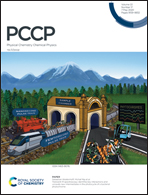Inelastic rate coefficients based on an improved potential energy surface for N2 + N2 collisions in a wide temperature range†
Abstract
A modification in the potential energy surface (PES) for N2–N2 interactions, reported in the literature [D. Cappelletti et al., Phys. Chem. Chem. Phys., 2008, 10, 4281], has been presented to improve its description of, particularly, the short range behavior for specific configurations, with the aim of producing a large database of vibration to vibration (V–V) and vibration to translation/rotation (V–T/R) energy transfer rate coefficients, with an increased accuracy extended to large temperature ranges relevant to the modeling of hypersonic gas flows. The modifications were introduced in a physically meaningful fashion and they are shown to improve the performance of the PES in a wide temperature range, not only for calculating rate coefficients, but also for determining a variety of physical properties. This new PES was then used to calculate V–V and V–T/R rate coefficients for inelastic N2–N2 collisions through a mixed quantum-classical method, based on the quantum treatment of molecular vibrations, for vibrationally excited states up to v = 40. Such a large V–T/R coefficient database is quite unprecedented, and the comparison of the efficiency of the related processes with the corresponding V–V coefficients shows that vibrational relaxation plays a very relevant role in high temperature regimes.



 Please wait while we load your content...
Please wait while we load your content...